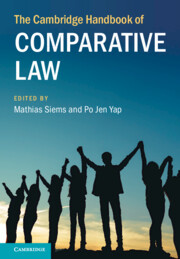Book contents
- The Cambridge Handbook of Comparative Law
- The Cambridge Handbook of Comparative Law
- Copyright page
- Contents
- Figures
- Tables
- Contributors
- Preface
- Abbreviations
- 1 Introduction
- Part I Methods of Comparative Law
- 2 Traditional Methods
- 3 Historical-Jurisprudential Methods
- 4 Critical Methods
- 5 Culture and Comparative Law Methodology
- 6 Linguistic Approaches
- 7 Qualitative Fieldwork
- 8 New Institutional Economics
- 9 Empirical Methods
- 10 Machine-Learning Methods
- Part II Legal Families and Geographical Comparisons
- Part III Central Themes in Comparative Law
- Part IV Comparative Law beyond the State
- Index
10 - Machine-Learning Methods
from Part I - Methods of Comparative Law
Published online by Cambridge University Press: 26 January 2024
- The Cambridge Handbook of Comparative Law
- The Cambridge Handbook of Comparative Law
- Copyright page
- Contents
- Figures
- Tables
- Contributors
- Preface
- Abbreviations
- 1 Introduction
- Part I Methods of Comparative Law
- 2 Traditional Methods
- 3 Historical-Jurisprudential Methods
- 4 Critical Methods
- 5 Culture and Comparative Law Methodology
- 6 Linguistic Approaches
- 7 Qualitative Fieldwork
- 8 New Institutional Economics
- 9 Empirical Methods
- 10 Machine-Learning Methods
- Part II Legal Families and Geographical Comparisons
- Part III Central Themes in Comparative Law
- Part IV Comparative Law beyond the State
- Index
Summary
Comparative lawyers are interested in similarities between legal systems. Artificial intelligence offers a new approach to understanding legal families. This chapter introduces machine-learning methods useful in empirical comparative law, a nascent field. This chapter provides a step-by-step guide to evaluating and developing legal family theories using machine-learning algorithms. We briefly survey existing empirical comparative law data sets, and then demonstrate how to visually explore these using a data set one of us compiled. We introduce popular and powerful algorithms of service to comparative law scholars, including dissimilarity coefficients, dimension reduction, clustering, and classification. The unsupervised machine-learning method enables researchers to develop a legal family scheme without the interference from existing schemes developed by human intelligence, thus providing a powerful tool to test comparative law theories. The supervised machine-learning method enables researchers to start with a baseline scheme (developed by human or artificial intelligence) and then extend it to previously unstudied jurisdictions.
Keywords
- Type
- Chapter
- Information
- The Cambridge Handbook of Comparative Law , pp. 177 - 208Publisher: Cambridge University PressPrint publication year: 2024

